Table of Contents
The shotgun is one of the most versatile firearms in existence. It is essentially more adaptable than many kinds of pistols and rifles. It has a wide range of cartridges (aka shells) and actions to choose from, and has been in military and civilian use for more than two centuries. From .410 to 10-gauge, it is one of the most influential weapons and sporting guns out there. Whether for home-defense or competition shooting, riot-control or close-quarter military action, the shotgun is a tour de force of firepower.
Shotguns have earned their place in history, and they endure as a symbol of Americana. The shotgun is a weapon which is closely associated with the Civil War, as well as the Old West. It is a tool which was the go-to firearm of cavalrymen, law keepers, and civilian militias alike. Why? Because, overall, it required less skill than other firearms. Shotgun shells propel a group of shot pellets, which spread out into a pattern once they leave the muzzle. You don’t necessarily need to have the best aim in order to hit the target. If you are physically close enough, and relatively on target, there is a good chance you will neutralize the enemy or take down your prey when you pull that trigger. Unlike revolvers or rifles, which fire a lone projectile and require more skill, shotguns could be used by a wider range of the population, and employed in a varying circumstances to boot.
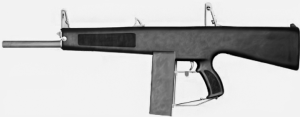
One the trigger has been pulled, the shell’s pellets shoot out and continue moving down their ballistic trajectory. Meanwhile, the pattern they create grows wider and wider. Once they reach the end of their effective range, they are
of no further use. And that, incidentally, is precisely where shotguns chokes come in.
Shotgun Chokes Explained
Shotgun chokes were invented in order to minimize the pattern of a shotgun, thus maximizing its hit potential. A choke acts as a sort of constrictor (hence the name), which is designed to create a tighter pattern and make a shot more effective. Now for a bit of history:
The first chokes were made available in the mid 19th century, and the credit for inventing them is split several ways. William Greener is credited, since his invention appeared in his 1881 book The Gun and its Development; another credit goes to Sylvester Roper, who patented chokes in 1886; and yet another credit belongs to William Pape, who filed a patent claim in London, a mere six weeks after Roper did. A final, somewhat obscure credit, goes out to a gunsmith named Jeremiah Smith, who was said to have invented the concept of the choke way back in 1827. Greener’s method for choke-creation is the one which was adopted by most other gunsmiths, which is why he is widely credited as the inventor of the choke, albeit not the concept itself.
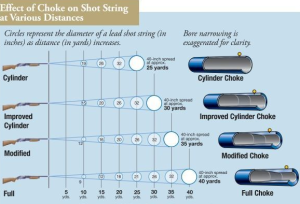
Greener got the idea from a customer in the 1860’s, and worked on inventing an actual shot constrictor for some time. The first ever mention of Greener’s choke was made in an article in the December 1874 edition of Field magazine. Following the magazine’s publication, Greener’s chokes were put to the test in several public trials (1875, 1877, 1879). Greener and his chokes had managed to emerge victorious in all competitions, and his name was made famous even prior to the publishing of his 1881 book.
Different targets call for different kinds of patterns, and for this reason there are many types of chokes available. Without including any specialty or otherwise lesser-known chokes, the standard choke types are: cylinder, improved cylinder, modified, improved modified, and full.
Different Types of Shotgun Chokes Explained
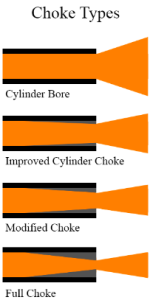
The end of a choke is smaller than the shotgun’s actual bore. The idea behind using a specific choke has a lot to do with the circumstances. Obviously, certain factors like target, range, and ammo should be taken into account, but it really is up to you and your style of shooting. People (especially online…) will always give you solicited and unsolicited advice on which choke to use, when, where, etc., but ultimately it is up to you and your preferences. So, let’s go a little bit deeper into each individual choke:
- Cylinder: This is a choke which offers no constriction on the bore, but it is used in order to create a wider pattern. The cylinder choke is considered very practical for home defense, because of that wide spread. The closer the target, the less constriction there should be on the pattern. For this reason, the cylinder is also widely used for different kinds of sport shooting.
- Improved cylinder: Offers a constriction of 0.010 inch, and is used to get a nice pattern up to about 30 yards. Like the aforementioned cylinder choke, it is also a popular choice with skeet, trap, and clay shooters.
- Modified: This choke provides a constriction of 0.020 inch, and is effective up to about 45 yards. Used by many hunters, this choke will do well when going after airborne birds and waterfowl. Some even use it on turkeys.
- Improved modified: A constriction of 0.025 inch, which is effective up to a range of 50 yards or so, and is used like the modified choke in many cases.
- Full: This choke is effective to the longest distances, and creates a constriction measuring 0.030 inch. It is used by turkey, duck, and goose hunters, but is not their exclusive domain by any means. Like I wrote earlier, it is up to you and your specific circumstances.
Improved Cylinder Choke allows you to hunt deer with your shotgun: pic.twitter.com/w0pPDXdx6N
— The Reverend Fowl™ (@TheReverendFowl) November 1, 2016
Shotgun Choke Tubes Explained
Some shotguns come with a fixed choke, and some come with a threaded barrel, which allows different choke tubes to be screwed in. The tube sizes vary according to the shotgun’s gauge. Threaded-barrel shotguns are more adaptable than fixed choke shotguns, but there is a danger there. If you fire a tightly-packed, high-grain shell through a cheaply-made choke, you could create a dangerous amount of pressure on the barrel, and potentially damage it. Likewise, if you fire a steel shot – as opposed to a lead shot – through an improved modified or full choke, there is a chance you could damage the barrel. Why? Because lead is a lot more flexible, as metals go.
Compared to steel, lead is a more versatile kind of shot, and it can be fired with any choke. Steel is more rigid, and may not take too kindly to forces trying to constrict its space. Again, it is a question of pressure, and it isn’t always true. Some companies, like Remington, manufacture full chokes which are engineered for use with steel or lead shells. There are those who invest thousands of dollars into their shotgun, but don’t think too much about the quality of their chosen chokes. That is at least one clear argument in favor of using a fixed choke shotgun. It may not have the versatility of a threaded-barrel shotgun, but you aren’t in danger of ruining your expensive barrel with a misplaced choke or shell.
Threaded barrel shotguns are used by those who shoot in varying circumstances. Shooting game, vermin, clay, paper targets – it can be a dynamic situation. Your could be getting closer or further away from the target, and fast. For this reason, shotguns with interchangeable chokes have been engineered. If you are going after larger game birds, for instance, and are interested in a nice clean head shot, you get to a practical distance, choose your choke according to size and range, and go for it. Besides increasing your chances of hitting the target, the right kind of choke also offers a more humane kill.
Shotgun Choke Markings
In order to differentiate the chokes from one another, a system of markings was put into place. It is not adhered to by all choke manufacturers, but is generally recognized as an effective method of telling chokes apart.
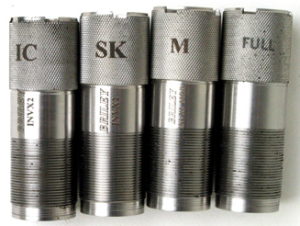
First, there is the lettering on the choke itself:
- Cylinder – has no lettering.
- Improved Cylinder – IC.
- Modified – M.
- Improved modified – IM.
- Full – F.
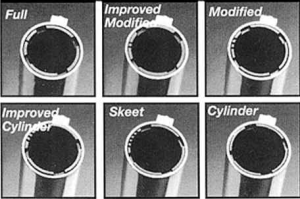
Second, the chokes are marked by a number of notches or stars:
- Cylinder – five notches / stars.
- Improved cylinder – four notches / stars.
- Modified – three notches / stars.
- Improved modified – two notches / stars.
- Full – one notch / star.

Third, chokes can be told apart by their color band.
- Cylinder – has no color band.
- Improved cylinder – yellow band.
- Modified – green band.
- Improved modified – black band.
- Full – white band.
Shotgun Choke Chart
The way a choke is measured is by the diameter of the pattern it creates at a fixed distance. For the purpose of this piece, we will using the classic example of a 30-inch spread at a distance of 40 yards. (Example taken from Wikipedia):
| Constriction (inch) | Lettering | Notches | Stars | % of pattern | |
| Cylinder | 0.000 | – | IIIII | ***** | 40 |
| Improved Cylinder | 0.010 | IC | IIII | **** | 45 |
| Modified | 0.020 | M | III | *** | 60 |
| Improved Modified | 0.025 | IM | II | ** | 65 |
| Full | 0.030 | F | I | * | 70 |
In accordance with what was written earlier, if our chosen distance had been 25 yards, for instance, then the spread percentage would have been much higher with the cylinder choke, and so forth. Like I said, it all has to do with circumstances. While it is true that the cylinder choke is used by many for home-defense, there are those who go another route, and use a shotgun fitted with a full choke, loaded with buckshots for maximum effectiveness at very close ranges. As the distance closes, so does the necessity of a specific choke. If you are faced with a target which is 10 or 20 feet away – across the hall, on the other side of the lawn, or at the entrance to a room – it won’t really matter what kind of choke you use. At those distances, the patterns are somewhat similar. It is when you get further away that the chokes really make a noticeable difference.
Benelli vs. Remington Shotgun Chokes
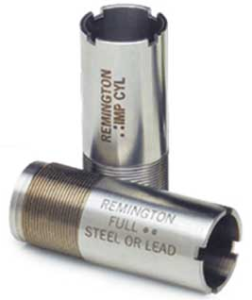
There are many choke tube systems and styles available. Some are interchangeable with other brands, some are not. Do some research, be fully aware of your shotgun’s versatility (or lack thereof), and be sure that you end up with the best and most convenient setup for your intended use. Two of the very best choke makers around are Benelli and Remington. I already mentioned the danger of using cheap choke tubes. If you want to look after your shotgun’s barrel, use chokes made by a reputable company. Both Remington and Benelli make standard chokes and specialty chokes (for certain types of clay and game hunting). Most Benelli shotguns are equipped with five cryogenically-treated Crio-series choke tubes. Remington’s chokes are split up into Rem chokes and Pro Bore chokes, and each has different attributes.
Conclusion
Shotgun chokes are something to consider very carefully. Some may say: meh, a shotgun is a shotgun, why should I care about a 0.010 of an inch? The truth is, whether you are hunting, protecting, or sport shooting, you will be able to improve your count and tighten your pattern many times over, all by simply using the right kind of choke. It may not apply to everyone – in fact, it definitely won’t apply to everyone – but to those who are interested in upping their game, so to speak, it is a tried and true method.
From the mid-1800s to the present day, shotgun chokes have been used to lengthen the effective range of shotgun shells. Shotguns have been making a big comeback in modern-day America, with many taking a liking to its home-defense attributes and wide variety of ammo. It has even been said that the mere sound of a pump-action shotgun racking is enough to make many intruders think twice before venturing another step. Nothing says ‘get the hell off my property!’ quite like a good old-fashioned shotgun.
Not all guns are created equally, and the same thing goes for shotgun chokes. Remember to treat your shotgun – and its accessories – with care, so that it can continue to serve you in the best possible way. Use the right amount of lubricant, use a proper wrench, don’t over-tighten the choke, don’t leave it too loose, and always remember: safety first!
Looking for more on shotguns? Check out our Kel-Tec KSG review right here at Gunivore!
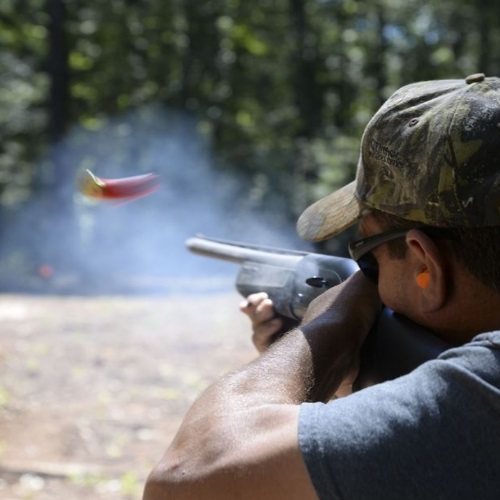
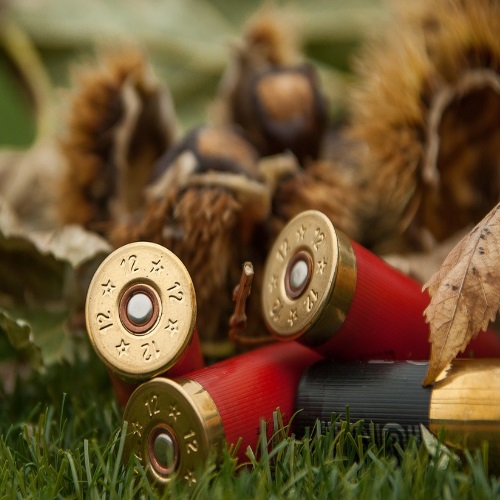

This is a nicely detailed article. Well done. One misconception I run into is that many shooters assume that if a tight choke is needed, then a tighter choke is better. Man, is that a wrong idea. Over choking has led to a ton of “missed” turkeys and waterfowl.